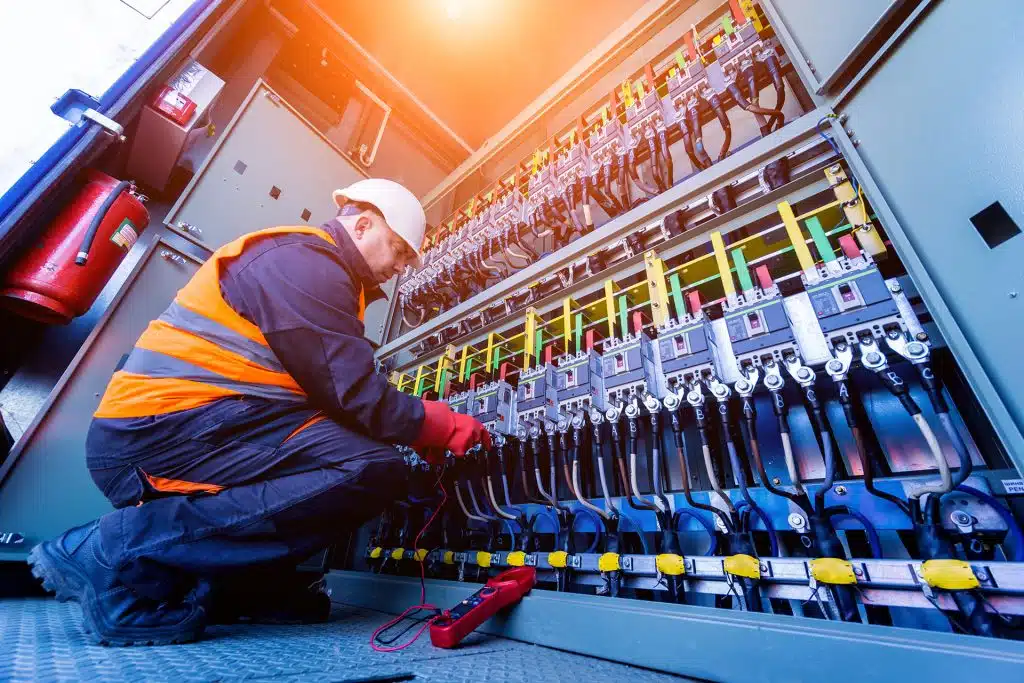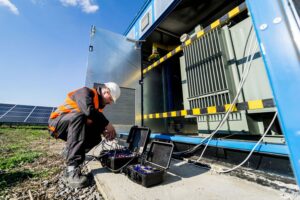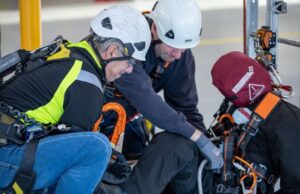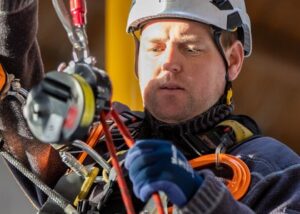Comparing the GWO CoHE to NFPA-70E standard training
Excellent electrical safety training and skills are crucial for wind technicians due to the unique and hazardous nature of their work. Wind turbines operate with complex electrical systems, including both low and high-voltage circuits, and technicians frequently work in challenging conditions, such as at great heights and in remote locations. These factors heighten the risks associated with electrical work and make rigorous safety training essential.
Firstly, wind turbines often utilize high-voltage systems to convert and transmit energy, exposing technicians to potentially fatal hazards like electrical shock, arc flash, and arc blast. Proper training ensures technicians understand these dangers, how to mitigate them, and how to follow safe work practices. Knowledge of personal protective equipment (PPE), Lockout/Tagout (LOTO) procedures, and approach boundaries are critical to preventing accidents during routine maintenance or troubleshooting tasks.
Secondly, electrical incidents in wind turbines can lead to catastrophic consequences, including fires, equipment damage, and serious injury or death. Electrical safety training helps technicians perform risk assessments, identify hazards, and apply appropriate safety measures before beginning work. This proactive approach minimizes the chances of accidents and enhances technicians’ ability to work safely under pressure.
Additionally, rapid technological advancements in the wind industry introduce new, sophisticated electrical components. Technicians must possess up-to-date skills to understand these systems, troubleshoot them effectively, and remain compliant with safety standards like NFPA 70E or GWO CoHE.
Finally, the remote and elevated nature of wind turbine work adds further complexity. Emergency responses in these environments can be challenging, making it vital for technicians to follow stringent electrical safety protocols to reduce the likelihood of incidents.
NFPA 70E is a standard developed by the National Fire Protection Association (NFPA) focused on electrical safety in the workplace. It outlines practices and procedures to protect workers from electrical hazards, such as shock, arc flash, and arc blast. The standard provides guidelines for safe work practices, personal protective equipment (PPE), risk assessment, and the establishment of electrically safe working conditions.
For wind technicians, NFPA 70E is highly applicable because they regularly work with both low and high-voltage electrical systems in wind turbines. These systems can expose technicians to significant risks, including electrical shock, arc flash, and fires. Following NFPA 70E helps wind technicians to safely perform maintenance, troubleshooting, and repairs by using proper procedures like Lockout/Tagout (LOTO), arc flash protection, and ensuring they are trained and qualified to work on live electrical parts.
The standard also mandates appropriate PPE, safe approach boundaries, and the need for detailed risk assessments before performing any electrical work. By adhering to NFPA 70E, wind technicians minimize the risks associated with electrical work, ensuring safer operations in the high-risk wind energy sector.
The Global Wind Organisation (GWO) Control of Hazardous Energies (CoHE) training standard is designed to ensure the safety of wind technicians when working with potentially hazardous energies in wind turbines, such as electrical, mechanical, hydraulic, and pneumatic systems. The CoHE training focuses on providing technicians with the knowledge and skills to safely isolate, control, and de-energize equipment, reducing the risk of injury or accidents in wind farms.
Applicability to Wind Technicians
For wind technicians, the GWO CoHE standard is essential because their work often involves interaction with various energy systems in wind turbines during maintenance, repair, and inspection activities. The CoHE training ensures they can safely manage these energy sources by:
- Identifying Hazards: Technicians are trained to recognize potential energy-related risks (e.g., moving parts, high voltage).
- Isolating Energy Sources: They learn how to safely isolate turbines from energy sources using Lockout/Tagout (LOTO) procedures and other safety mechanisms.
- Verifying De-Energization: After isolation, technicians are trained to confirm the absence of hazardous energy before performing work.
- Applying Safety Procedures: They follow structured safety procedures to prevent inadvertent re-energization while working on turbines.
This training ensures that wind technicians can competently control and manage hazardous energy, helping to prevent accidents, equipment damage, or electrical shock during operations.
Difference Between GWO CoHE and NFPA 70E
While both GWO CoHE and NFPA 70E address electrical safety, they differ in their focus and scope:
NFPA 70E is a comprehensive standard that covers workplace electrical safety across multiple industries, focusing primarily on electrical hazards, such as arc flash, electric shock, and arc blast. It provides detailed guidelines on electrical risk assessment, use of Personal Protective Equipment (PPE), and safe work practices specific to electrical systems. NFPA 70E is widely used in the U.S. and addresses electrical hazards in various sectors, including wind energy.
GWO CoHE, on the other hand, is specifically tailored to the wind energy industry and covers multiple types of hazardous energy sources, not just electrical. While electrical hazards are a part of the training, CoHE also emphasizes controlling other energy types found in wind turbines, such as mechanical and hydraulic. The CoHE training provides a more industry-specific, holistic approach to managing the diverse energy hazards wind technicians face.
In summary, NFPA 70E is more focused on electrical safety, whereas GWO CoHE offers a broader, wind industry-specific approach to handling various hazardous energies.
While the GWO CoHE training standard is essential for wind technicians, it may not be entirely sufficient for ensuring complete safety in all aspects of their work on wind turbines.
Firstly, CoHE focuses broadly on hazardous energies but may lack in-depth, specialized training in certain critical areas, particularly high-voltage electrical safety. Wind turbines often involve complex high-voltage systems that require advanced knowledge of arc flash, shock hazards, and precise electrical risk assessments, areas where NFPA 70E offers more detailed guidance. Without this deeper understanding, technicians might face electrical risks that aren’t fully covered by CoHE.
Secondly, the scope of CoHE is relatively generic to various energy types, which may lead to gaps in handling site-specific hazards or unique turbine designs. Wind farms in different regions can have variations in their electrical systems or operational environments that demand more tailored safety training than CoHE offers.
Lastly, CoHE’s focus on procedural safety, such as Lockout/Tagout (LOTO), may not sufficiently prepare technicians for unforeseen emergencies or rare incidents, like arc blasts or equipment failures, which could require specialized safety responses not emphasized in the training.
Therefore, additional industry-specific and electrical safety training beyond GWO CoHE may be necessary for comprehensive safety.
Book electrical safety training
Interested in world-class electrical safety training for working on wind turbines? Click the button to find out more and book.




